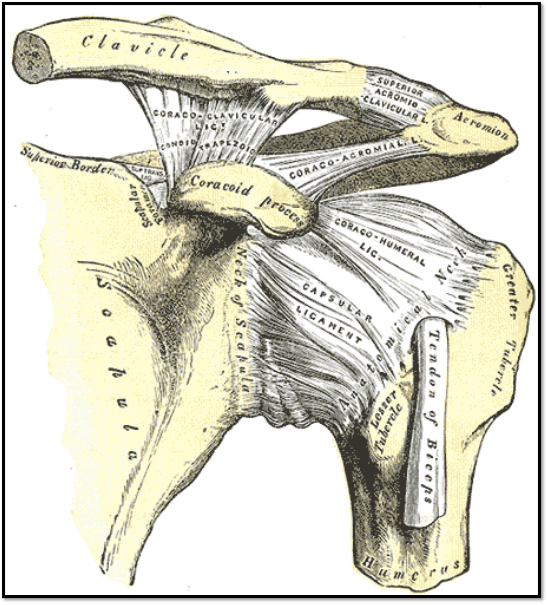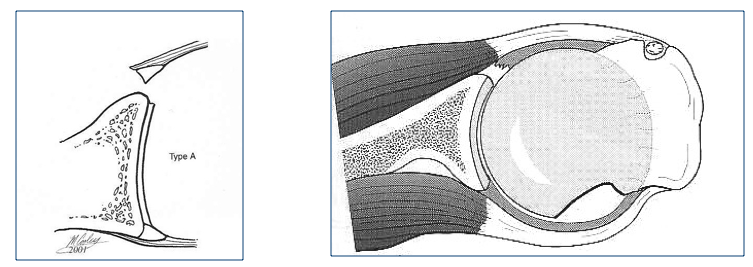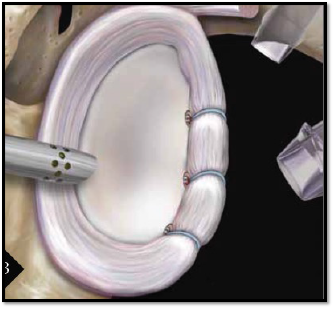Having an unstable shoulder may be due to complete dislocations, or episodes of partial dislocation. This can result in recurrent complete dislocations, pain or even just a lack of confidence in the shoulder.
Over time shoulder ongoing instability can lead to arthritis of the shoulder. Generally, the younger the age of initial dislocation, the higher the risk of recurrence.
 ANATOMY
ANATOMY
The shoulder is a ball and socket joint. It is a bit like a golf ball sitting on a golf tee. This means that the socket, which is very shallow relies on the surrounding muscles and ligaments to keep in joint.
Around the outside of the shoulder joint is a ring of cartilage called the labrum. This deepens the joint, and also provides support for the attachment of the strong ligaments that help keep the shoulder in place.
Covering the shoulder like a cloak, are the ligaments of the shoulder. These are important for the stability of the shoulder, but they also act as a mechanism to give the muscles feedback during episodes of stretching thereby helping keep the shoulder stable.
INJURY
Injury to the shoulder most often occurs when the shoulder wrenches the supporting ligaments off their attachment to the socket (glenoid). Most often the supporting labrum is also damaged, and in some cases there is a fracture of the bony socket. These are known as soft tissue and bony Bankart lesions. Other patterns of injury can also occur, however this is the most common scenario.

Above is cross sectional image demonstrating a Bankart lesion and the Hill-Sachs lesion in the humeral head. (Uber operation bei habitueller schulterluxation. Perthes G. Dtsch Z Chir 1906; The pathology and treatment of recurrent dislocation of the shoulder joint. Bankart B Br J Surg 1938)
Investigation of a shoulder dislocation should start with an xray. Following this a CT is required for those with a bony injury, and an MRI for those with a soft tissue injury as described above.
TREATMENT
The treatment for shoulder instability needs to be tailored to the individual. For those whos functional demands are not as critical, non-operative management may reduce the feelings of looseness and activity avoidance. A sling and physiotherapy focusing on muscle training and proprioception can lead to a good result
Generally younger, more active patients who have had a traumatic episode of instability with a Bankart lesion, are best treated with arthroscopic stabilization as it yields the best results, by decreasing the chance of ongoing episodes of instability.
The first line of surgical reconstruction is via a key hole technique. This is done under a general anaesthetic. During this procedure small anchors are placed into the edge of the bone and stitches used to secure the labrum and capsule back to its origin.
POST-OPERATIVE RECOVERY
After the procedure you will be prescribed pain relief medication. You will need this for around 5 days. The small dressings covering the sutures may be removed and replaced if they are soiled. The sutures should be removed at day 10. During the first few days you ma shower, but not soak the dressings each day.
Generally a sling is required for the first 4-6 weeks. This should be worn all day, only being taken off for short periods of rest or exercise. It is important that there is not excessive movement or wrenching of the shoulder during this time as the tissues need to heal.
Physiotherapy is an important part of the rehabilitation. There are guidelines for this on the Post-operative physiotherapy section of this web page.
Return to sedentary work including basic computer work can resume at 2-4 weeks.
No physical work should be begun while the sling is still in use.
Return to heavy physical work is dependent on progress and requirements. Generally this will take 4 – 6 months. This can be a good time to gain more skills prior to returning to work.
Return to sport and manual work should be graded. General guidelines include:-
Running – 8 weeks
Swimming – 3 months
Slow return to throwing sports at 4 months
Contact sport should only begin at 6 months
